Airbrush makeup and traditional makeup are two distinct techniques used for cosmetic application, each with its own set of advantages and disadvantages. Airbrush makeup utilizes an airbrush tool to create a fine mist, resulting in a smooth, long-lasting finish, while traditional makeup involves applying products with brushes or sponges, offering versatility but often requiring more frequent touch-ups. The article explores the differences in application techniques, tools, formulations, and skin compatibility, as well as the pros and cons of each method. Key considerations include longevity, skin type suitability, and personal preferences, providing a comprehensive overview for individuals deciding between the two makeup styles.
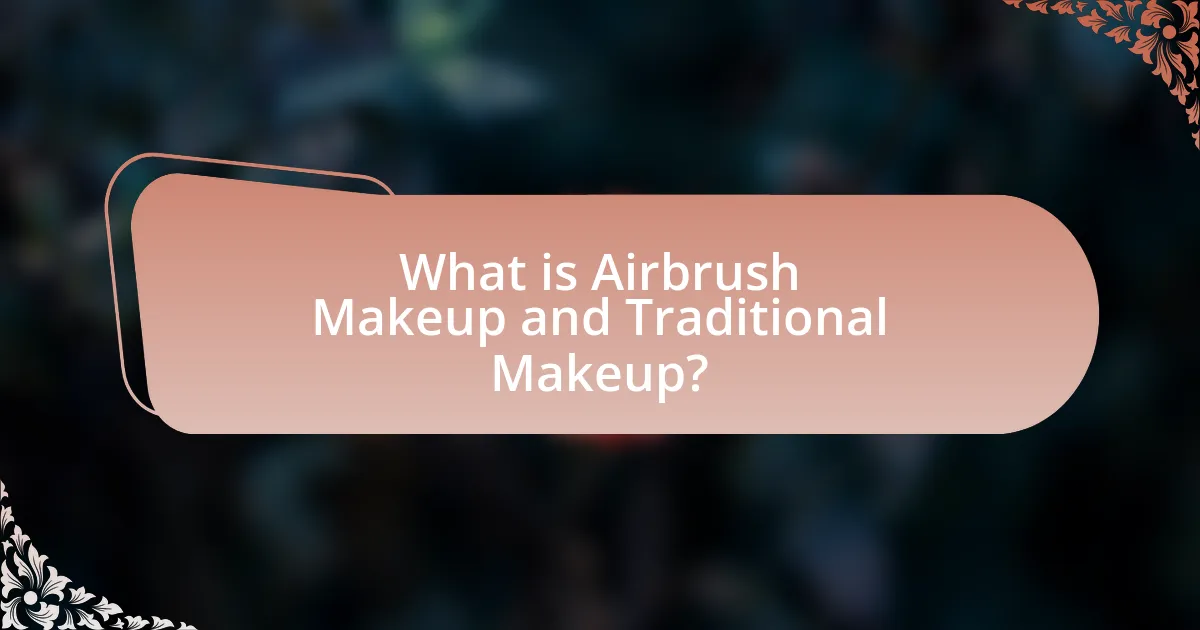
What is Airbrush Makeup and Traditional Makeup?
Airbrush makeup is a technique that uses an airbrush tool to apply foundation and other makeup products in a fine mist, resulting in a smooth, even finish. Traditional makeup, on the other hand, involves applying products like foundation, concealer, and powder using brushes, sponges, or fingers, which can lead to a more textured appearance. Airbrush makeup is often preferred for its long-lasting and lightweight feel, while traditional makeup is valued for its versatility and ease of application.
How do Airbrush Makeup and Traditional Makeup differ in application techniques?
Airbrush makeup and traditional makeup differ primarily in their application techniques, with airbrush makeup utilizing a specialized airbrush tool to spray a fine mist of foundation onto the skin, while traditional makeup involves using brushes, sponges, or fingers to apply products directly. The airbrush technique allows for a more even and lightweight finish, often resulting in a flawless appearance that can last longer, as it is designed to be water-resistant and provides a buildable coverage. In contrast, traditional makeup can vary in texture and finish depending on the products used, and it may require more frequent touch-ups throughout the day.
What tools are used in Airbrush Makeup?
Airbrush makeup utilizes specific tools including an airbrush gun, a compressor, and airbrush makeup products. The airbrush gun is designed to spray a fine mist of makeup onto the skin, allowing for an even and flawless application. The compressor provides the necessary air pressure to operate the airbrush gun effectively. Airbrush makeup products are specially formulated to be lightweight and suitable for airbrushing, ensuring a smooth finish. These tools collectively enhance the application process, making it distinct from traditional makeup methods.
What tools are used in Traditional Makeup?
Traditional makeup utilizes a variety of tools including brushes, sponges, and applicators. Brushes are essential for applying foundation, blush, and eyeshadow, while sponges are often used for blending and achieving a smooth finish. Additionally, applicators such as cotton swabs and fingers may be employed for precise application and touch-ups. These tools have been standard in the beauty industry for decades, allowing for versatility and creativity in makeup application.
What are the main ingredients in Airbrush Makeup and Traditional Makeup?
Airbrush makeup primarily consists of water-based or silicone-based foundations, pigments, and setting agents, while traditional makeup typically includes cream or powder foundations, oils, waxes, and various pigments. The water-based formulations in airbrush makeup allow for a lightweight application that can be easily blended, whereas traditional makeup’s ingredients provide a thicker consistency and varied textures. The use of silicone in airbrush products enhances durability and smoothness, while traditional makeup often relies on oils and waxes for moisture and adherence to the skin.
How do the ingredients affect skin types?
Ingredients in makeup products significantly affect various skin types by influencing hydration, oiliness, sensitivity, and overall skin health. For instance, ingredients like hyaluronic acid and glycerin provide hydration, making them suitable for dry skin types, while oil-free formulations with silica or kaolin clay help control shine for oily skin types. Additionally, sensitive skin types benefit from hypoallergenic ingredients such as aloe vera and chamomile, which soothe irritation. Research indicates that certain ingredients can exacerbate conditions like acne or eczema, highlighting the importance of selecting products tailored to specific skin needs.
What are the differences in formulation between the two types?
Airbrush makeup and traditional makeup differ significantly in their formulation. Airbrush makeup consists of a liquid formula that is specifically designed to be sprayed through an airbrush machine, allowing for a fine mist application that creates a smooth, even finish. In contrast, traditional makeup typically includes cream, powder, or liquid formulations that are applied manually with brushes, sponges, or fingers, resulting in a more textured appearance.
The formulation of airbrush makeup often contains silicone-based ingredients, which provide a long-lasting, water-resistant finish, while traditional makeup may rely on oil or water-based components, which can vary in durability and texture. This distinction in formulation affects not only the application technique but also the overall wear and appearance of the makeup on the skin.
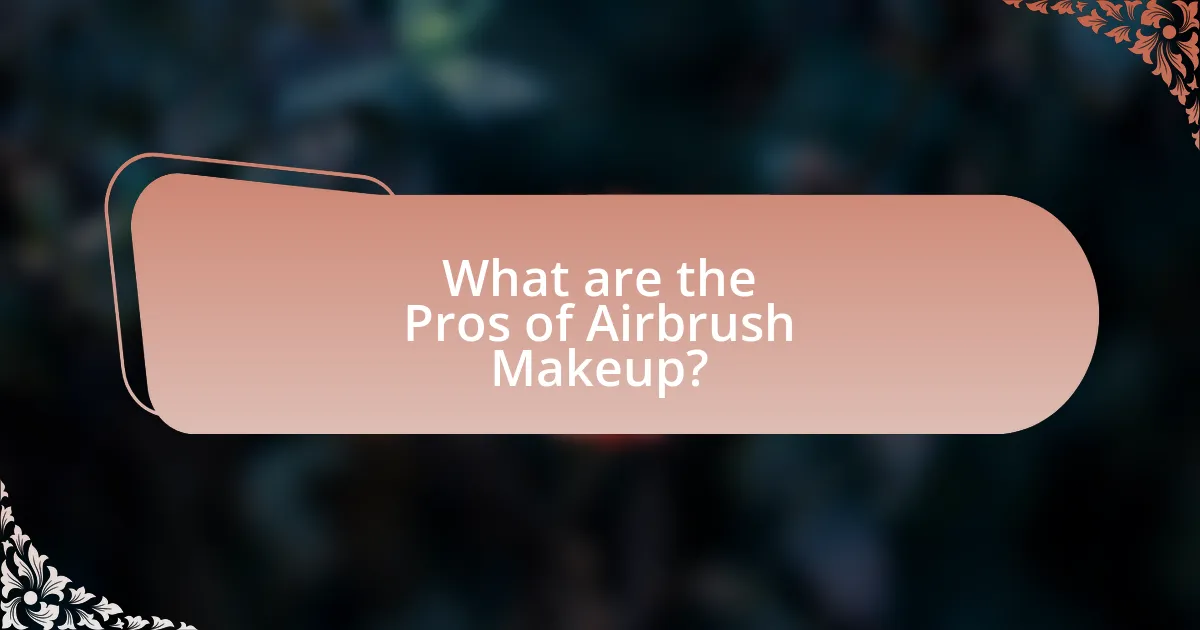
What are the Pros of Airbrush Makeup?
Airbrush makeup offers several advantages, including a flawless finish, long-lasting wear, and a lightweight feel. The application technique uses a fine mist to evenly distribute the makeup, resulting in a smooth and natural appearance that minimizes the visibility of pores and imperfections. Additionally, airbrush makeup is resistant to sweat and humidity, making it ideal for events like weddings or photoshoots where durability is essential. Studies have shown that airbrush makeup can last up to 16 hours without touch-ups, providing a reliable option for all-day wear. Furthermore, the hypoallergenic formulas often used in airbrush makeup cater to sensitive skin, reducing the risk of irritation.
How does Airbrush Makeup enhance the appearance of the skin?
Airbrush makeup enhances the appearance of the skin by providing a smooth, even finish that minimizes imperfections. This technique uses a fine mist of foundation, which allows for a lightweight application that blends seamlessly into the skin, creating a natural look. Studies have shown that airbrush makeup can reduce the visibility of pores and fine lines, resulting in a more youthful appearance. Additionally, the formula used in airbrush makeup often contains skin-beneficial ingredients, which can improve skin texture and hydration, further enhancing the overall look.
What benefits does Airbrush Makeup provide for photography and events?
Airbrush makeup provides a flawless, long-lasting finish that enhances the appearance of skin in photography and events. This technique uses a fine mist to apply foundation, which minimizes the appearance of pores and imperfections, resulting in a smooth and even complexion. Additionally, airbrush makeup is resistant to sweat and humidity, making it ideal for events where individuals may be exposed to varying conditions. Studies have shown that airbrush makeup can last up to 16 hours without touch-ups, ensuring that the subject looks their best throughout the duration of the event.
How long does Airbrush Makeup typically last compared to Traditional Makeup?
Airbrush makeup typically lasts longer than traditional makeup, with a duration of 12 to 24 hours compared to traditional makeup, which generally lasts around 6 to 8 hours. The longevity of airbrush makeup is attributed to its formulation, which often includes silicone-based products that create a more durable finish. Studies indicate that the fine mist application of airbrush makeup allows for better adherence to the skin, enhancing its staying power throughout the day.
What are the convenience factors of using Airbrush Makeup?
Airbrush makeup offers several convenience factors, including a quick application process, long-lasting wear, and a lightweight feel. The airbrush technique allows for even coverage in a shorter time compared to traditional makeup methods, which often require multiple layers and blending. Additionally, airbrush makeup is resistant to smudging and fading, making it ideal for long events or hot climates. Studies indicate that airbrush makeup can last up to 12-16 hours without touch-ups, providing a reliable option for users. Furthermore, the fine mist application minimizes the appearance of pores and imperfections, enhancing the overall finish and reducing the need for additional products.
How does the application process of Airbrush Makeup save time?
The application process of Airbrush Makeup saves time by allowing for a quicker and more efficient application compared to traditional makeup methods. Airbrush systems deliver a fine mist of foundation, which can cover larger areas of the face in a shorter amount of time, reducing the need for multiple layers and blending. Studies indicate that airbrush application can be completed in approximately 30 minutes, while traditional makeup application often takes 45 minutes to an hour due to the need for manual blending and layering. This efficiency is particularly beneficial for events where time is limited, such as weddings or photoshoots.
What are the portability advantages of Airbrush Makeup kits?
Airbrush makeup kits offer significant portability advantages due to their compact design and lightweight components. These kits typically include a small air compressor and a handheld airbrush, making them easy to transport for on-the-go applications, such as travel or events. The streamlined nature of airbrush kits allows for quick setup and breakdown, facilitating use in various locations without the need for extensive space or equipment. Additionally, many airbrush kits come with carrying cases, further enhancing their convenience for mobile makeup artists or individuals who prefer to apply makeup away from home.
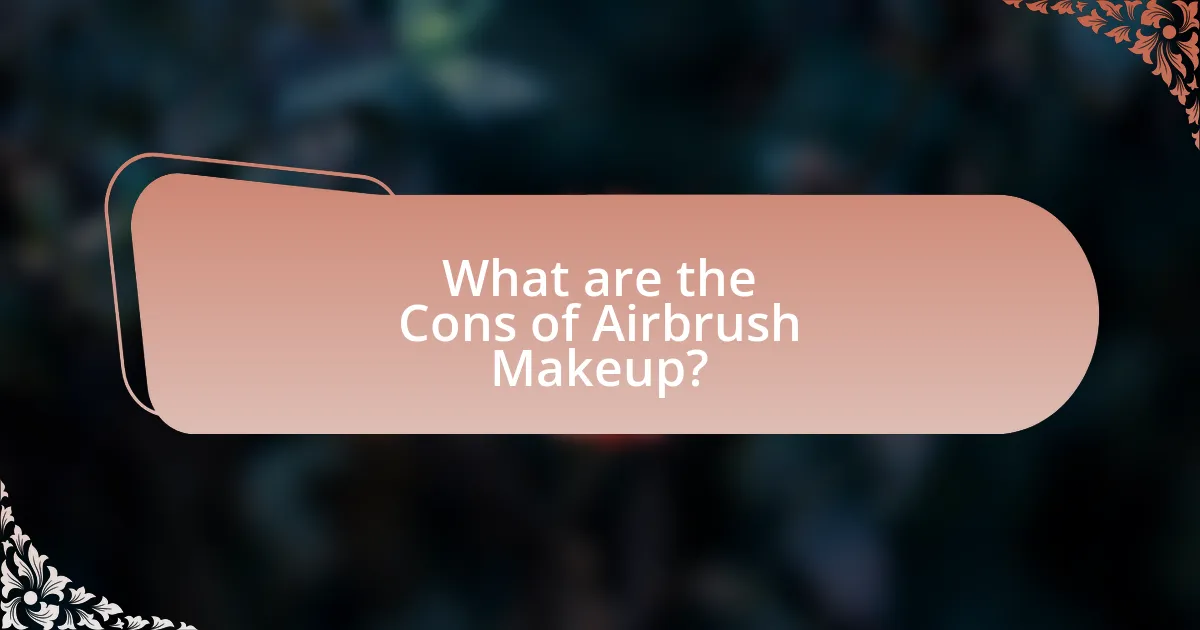
What are the Cons of Airbrush Makeup?
The cons of airbrush makeup include its higher cost, potential for uneven application, and the need for specialized equipment and training. Airbrush makeup typically requires a significant investment in both the airbrush system and the makeup products, making it more expensive than traditional makeup options. Additionally, achieving a flawless finish can be challenging, as uneven application may occur if the user lacks experience or skill. Furthermore, airbrush makeup necessitates specific equipment, which can be cumbersome and requires maintenance, along with training to master the technique effectively.
What challenges do users face when applying Airbrush Makeup?
Users face several challenges when applying airbrush makeup, primarily related to the technique and equipment. Mastering the airbrush application requires practice, as achieving an even and flawless finish can be difficult for beginners. Additionally, the need for specific equipment, such as an air compressor and airbrush gun, can be a barrier, as these tools can be expensive and require maintenance. Users also encounter issues with product compatibility, as not all makeup formulations are suitable for airbrush application, which can lead to clogging and uneven application. Furthermore, the learning curve associated with adjusting air pressure and distance from the skin can complicate the process, making it less user-friendly compared to traditional makeup methods.
How does the learning curve for Airbrush Makeup compare to Traditional Makeup?
The learning curve for airbrush makeup is generally steeper than that for traditional makeup. Airbrush makeup requires proficiency in using specialized equipment, such as an airbrush gun and compressor, which can be complex for beginners. In contrast, traditional makeup techniques, involving brushes and sponges, are more intuitive and accessible, allowing for quicker mastery. Studies indicate that while traditional makeup can be learned in a few sessions, mastering airbrush techniques may take several weeks of practice to achieve a professional level of application.
What are the potential issues with equipment maintenance?
Potential issues with equipment maintenance include equipment failure, increased operational costs, and safety hazards. Equipment failure can occur due to inadequate maintenance schedules, leading to unexpected breakdowns that disrupt operations. Increased operational costs arise from the need for frequent repairs and replacements when maintenance is neglected. Safety hazards may result from malfunctioning equipment, posing risks to users and clients. According to a study by the National Institute for Occupational Safety and Health, improper maintenance can lead to accidents and injuries, highlighting the importance of regular upkeep to ensure safety and efficiency in operations.
Are there any skin concerns associated with Airbrush Makeup?
Airbrush makeup can cause skin concerns such as clogged pores, allergic reactions, and irritation. The fine mist of airbrush makeup can settle into pores, potentially leading to breakouts, especially for individuals with acne-prone skin. Additionally, some formulations may contain allergens or irritants that can provoke skin sensitivities, resulting in redness or rashes. Studies indicate that products with heavy silicone content, often used in airbrush makeup, can exacerbate these issues for sensitive skin types.
How can Airbrush Makeup affect sensitive skin?
Airbrush makeup can positively affect sensitive skin by providing a lightweight, breathable finish that minimizes the risk of irritation. The application method uses a fine mist, which reduces the need for heavy layering and can help avoid clogging pores, a common issue for sensitive skin types. Additionally, many airbrush makeup products are formulated with hypoallergenic ingredients, which further decreases the likelihood of allergic reactions. Studies indicate that airbrush makeup can lead to less skin trauma compared to traditional makeup application techniques, as it does not require rubbing or pulling on the skin.
What are the risks of allergic reactions to Airbrush Makeup products?
Airbrush makeup products can pose risks of allergic reactions due to their chemical compositions, which may include allergens such as fragrances, preservatives, and certain pigments. Individuals with sensitive skin or known allergies to specific ingredients may experience symptoms like redness, itching, swelling, or even more severe reactions such as hives or anaphylaxis. According to a study published in the Journal of Cosmetic Dermatology, approximately 10-15% of individuals using cosmetic products report adverse reactions, highlighting the importance of patch testing before application.
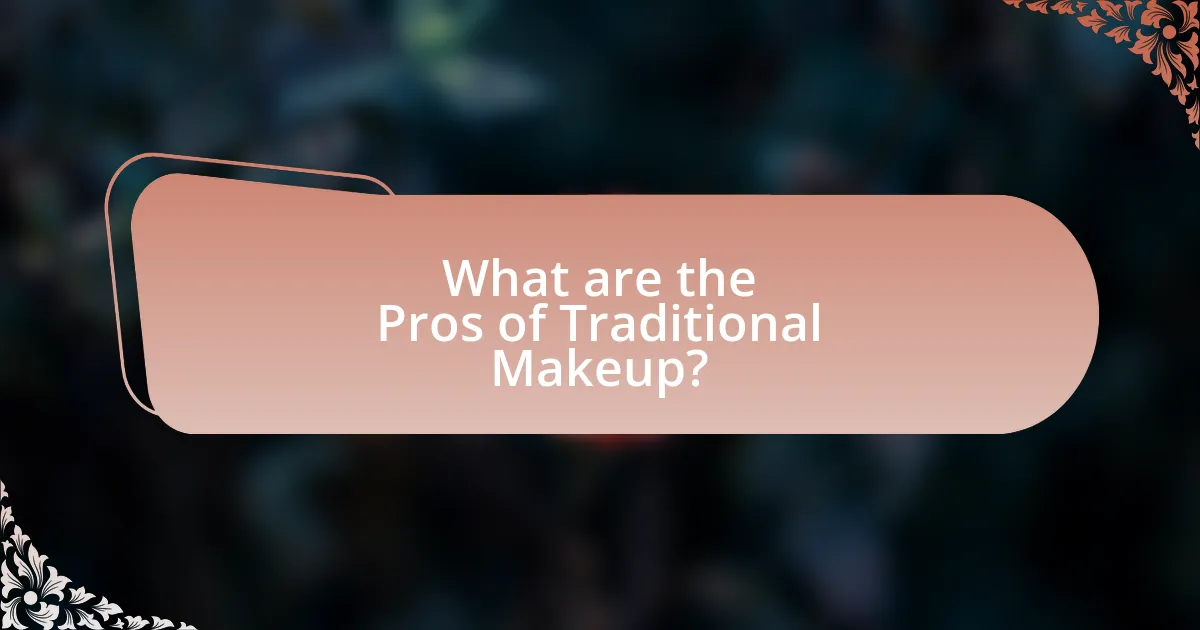
What are the Pros of Traditional Makeup?
The pros of traditional makeup include its wide range of product options, ease of application, and versatility for various looks. Traditional makeup products, such as powders, creams, and liquids, offer diverse finishes and textures, allowing users to achieve everything from natural to dramatic looks. Additionally, traditional makeup is often more accessible and can be applied without specialized equipment, making it user-friendly for individuals of all skill levels. Furthermore, many traditional makeup products contain skin-nourishing ingredients, which can benefit the skin while providing coverage.
How does Traditional Makeup offer versatility in looks?
Traditional makeup offers versatility in looks by allowing for a wide range of application techniques, products, and finishes. This adaptability enables users to create everything from natural, everyday looks to bold, dramatic styles. For instance, traditional makeup includes various formulations such as creams, powders, and liquids, which can be layered and blended to achieve different effects. Additionally, the use of diverse tools like brushes, sponges, and fingers allows for personalized application methods that cater to individual preferences and skin types. This flexibility is supported by the fact that traditional makeup has been used for centuries across different cultures, showcasing its ability to adapt to various beauty standards and trends.
What types of finishes can be achieved with Traditional Makeup?
Traditional makeup can achieve various finishes, including matte, dewy, satin, and luminous. The matte finish provides a flat, shine-free look, ideal for oily skin types, while the dewy finish offers a fresh, hydrated appearance, often preferred for dry skin. Satin finishes strike a balance between matte and dewy, providing a soft glow without excessive shine. Luminous finishes enhance the skin’s natural radiance, often achieved with highlighters or illuminating products. These finishes are determined by the types of products used, such as powders, creams, and liquids, which can be layered and blended to create the desired effect.
How does Traditional Makeup cater to different skin tones?
Traditional makeup caters to different skin tones by offering a wide range of shades and formulations designed to match various undertones and complexions. Brands often develop extensive color palettes that include warm, cool, and neutral tones, ensuring that individuals with diverse skin tones can find suitable products. For instance, major cosmetic companies like Fenty Beauty have been recognized for their inclusive shade ranges, offering over 40 foundation shades to accommodate a variety of skin tones. This approach allows traditional makeup to provide personalized solutions, enhancing the natural beauty of individuals across the spectrum of skin colors.
What are the cost advantages of Traditional Makeup?
Traditional makeup offers significant cost advantages primarily due to its lower initial investment and accessibility. Unlike airbrush makeup, which requires specialized equipment and ongoing maintenance, traditional makeup products such as foundations, powders, and lipsticks are generally more affordable and widely available. For instance, a basic set of traditional makeup can be purchased for as little as $50, while airbrush systems can range from $200 to over $1,000. Additionally, traditional makeup products often have a longer shelf life and do not require the purchase of replacement parts or additional tools, further reducing long-term costs.
How does the price of Traditional Makeup compare to Airbrush Makeup?
Traditional makeup generally costs less than airbrush makeup. The average price for traditional makeup services ranges from $50 to $150, while airbrush makeup services typically start at around $100 and can go up to $300 or more, depending on the complexity and duration of the application. This price difference is largely due to the specialized equipment and techniques required for airbrush makeup, which often results in a more polished finish and longer-lasting wear.
What are the options for budget-friendly Traditional Makeup products?
Budget-friendly traditional makeup products include brands like e.l.f., Wet n Wild, and NYX, which offer a variety of cosmetics at low prices. For example, e.l.f. provides quality foundations and lip products starting as low as $3, while Wet n Wild is known for its affordable eyeshadow palettes and blushes, often priced under $5. NYX also offers a wide range of products, including high-quality lipsticks and eyeliners, typically around $7. These brands are widely recognized for their effectiveness and affordability, making them accessible options for consumers seeking traditional makeup without overspending.
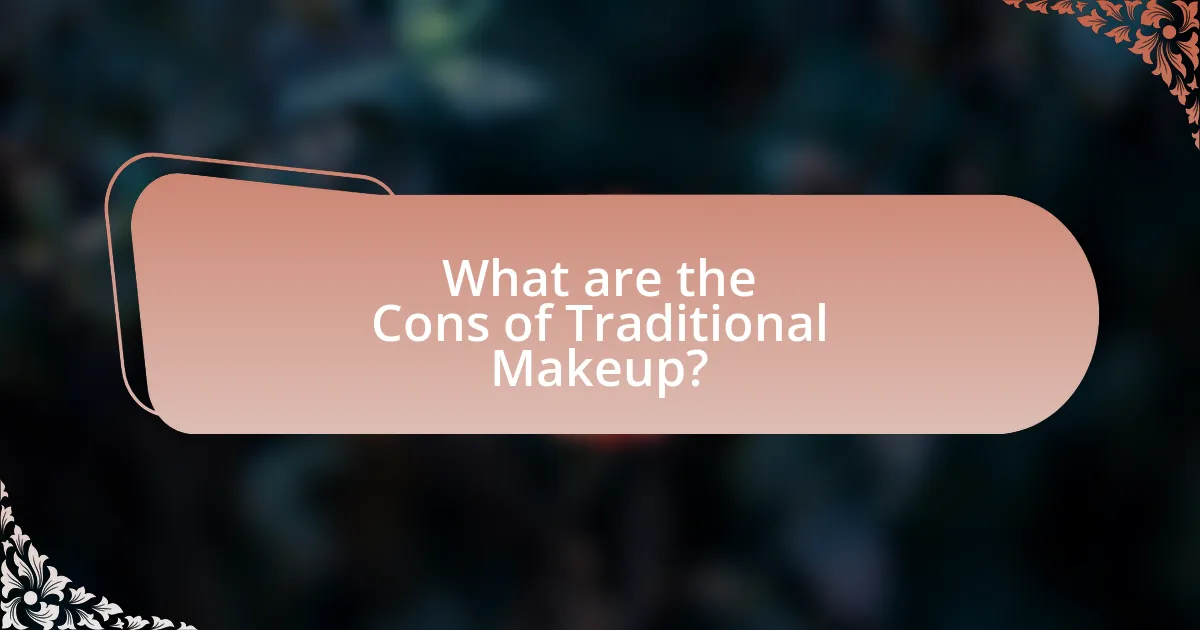
What are the Cons of Traditional Makeup?
The cons of traditional makeup include potential skin irritation, limited longevity, and the use of harmful chemicals. Traditional makeup often contains ingredients like parabens and fragrances that can cause allergic reactions or irritate sensitive skin. Additionally, traditional makeup typically requires frequent touch-ups throughout the day, as it may not withstand heat or humidity as effectively as other options. Studies have shown that certain conventional makeup products can contain toxic substances, raising concerns about long-term skin health and safety.
What are the limitations of Traditional Makeup in terms of longevity?
Traditional makeup has significant limitations in terms of longevity, primarily due to its formulation and application methods. Traditional products often contain water-based ingredients that can break down quickly when exposed to sweat, humidity, or oil, leading to fading and smudging within a few hours. Additionally, traditional makeup typically requires frequent touch-ups to maintain its appearance, as it does not adhere as well to the skin compared to airbrush makeup, which uses a fine mist application that creates a more durable finish. Studies indicate that traditional makeup can last anywhere from 4 to 8 hours under normal conditions, while airbrush makeup can last up to 16 hours or more, demonstrating a clear disparity in longevity.
How does Traditional Makeup perform in humid conditions?
Traditional makeup tends to perform poorly in humid conditions, often leading to issues such as smudging, fading, and increased shine. The high moisture levels in the air can cause traditional products, which are typically oil-based or cream-based, to break down more quickly, resulting in a less polished appearance. Studies indicate that in environments with humidity levels above 60%, traditional makeup can lose its adherence to the skin, leading to uneven application and the need for frequent touch-ups.
What are the common issues with Traditional Makeup touch-ups?
Common issues with traditional makeup touch-ups include uneven application, smudging, and the potential for a cakey appearance. Uneven application often occurs due to the use of sponges or brushes that can distribute product inconsistently, leading to patches or streaks. Smudging is a frequent problem, especially in humid conditions or during physical activity, as traditional makeup may not adhere as well as other formulations. Additionally, traditional makeup can appear cakey when layered excessively during touch-ups, which can detract from a natural look. These issues highlight the limitations of traditional makeup in maintaining a flawless appearance throughout the day.
Are there any skin concerns associated with Traditional Makeup?
Yes, there are several skin concerns associated with traditional makeup. Traditional makeup often contains ingredients like talc, parabens, and synthetic dyes, which can lead to skin irritation, allergic reactions, and breakouts. Studies have shown that these ingredients can clog pores and exacerbate conditions such as acne and eczema. Additionally, the use of traditional makeup can contribute to skin dryness and premature aging due to the presence of alcohol and other drying agents.
How can Traditional Makeup contribute to clogged pores?
Traditional makeup can contribute to clogged pores primarily due to its formulation, which often includes oils, waxes, and heavy pigments. These ingredients can create a barrier on the skin, trapping dirt, sweat, and dead skin cells, leading to pore blockage. Studies indicate that products containing comedogenic ingredients, such as certain silicones and mineral oils, are more likely to cause acne and clogged pores. For instance, a study published in the Journal of the American Academy of Dermatology highlights that makeup products with high oil content can exacerbate acne in individuals with oily skin. Therefore, the use of traditional makeup, particularly those not labeled as non-comedogenic, can significantly increase the risk of clogged pores.
What are the risks of using expired Traditional Makeup products?
Using expired traditional makeup products poses several risks, including skin irritation, allergic reactions, and reduced effectiveness. The degradation of ingredients over time can lead to the growth of bacteria and mold, which can cause infections or exacerbate skin conditions. For instance, a study published in the Journal of Cosmetic Dermatology found that expired cosmetics can harbor harmful microorganisms, increasing the likelihood of adverse skin reactions. Additionally, the chemical composition of makeup can change, leading to unpredictable results, such as uneven application or altered color. Therefore, using expired traditional makeup can compromise both skin health and cosmetic performance.
How can one choose between Airbrush Makeup and Traditional Makeup?
To choose between airbrush makeup and traditional makeup, consider factors such as skin type, desired finish, and longevity. Airbrush makeup provides a lightweight, flawless finish and is often more resistant to sweat and humidity, making it ideal for long events or hot climates. In contrast, traditional makeup offers more versatility in texture and application techniques, allowing for a more personalized look. According to a study published in the Journal of Cosmetic Dermatology, airbrush makeup can last up to 16 hours without touch-ups, while traditional makeup typically requires reapplication every few hours. Therefore, the choice depends on individual preferences and specific event requirements.
What factors should be considered when deciding on a makeup type?
When deciding on a makeup type, factors such as skin type, occasion, desired finish, longevity, and application technique should be considered. Skin type influences product compatibility; for example, oily skin may benefit from matte finishes, while dry skin may require hydrating formulas. The occasion dictates the level of coverage and durability needed; events like weddings may necessitate long-lasting options. Desired finish, whether matte or dewy, affects the choice of products, as different formulations yield varying results. Longevity is crucial for all-day wear, with airbrush makeup typically offering superior staying power compared to traditional makeup. Lastly, application technique varies; airbrush makeup requires specialized equipment and skill, while traditional makeup can be applied with basic tools.
How can personal preferences influence the choice between the two?
Personal preferences significantly influence the choice between airbrush makeup and traditional makeup by determining factors such as desired finish, application technique, and skin type compatibility. For instance, individuals who prefer a lightweight, flawless finish may lean towards airbrush makeup, which provides a smooth, even application and is often favored for special occasions. Conversely, those who appreciate the tactile experience and versatility of traditional makeup may opt for it, as it allows for layering and customization. Additionally, preferences related to skin sensitivity can guide choices; airbrush makeup is often hypoallergenic, appealing to those with sensitive skin, while traditional makeup may offer a broader range of shades and textures. These preferences ultimately shape the decision-making process, reflecting individual values and aesthetic goals.
What are some tips for achieving the best results with either makeup type?
To achieve the best results with either airbrush or traditional makeup, ensure proper skin preparation. For airbrush makeup, use a hydrating primer to create a smooth canvas, as this type of makeup relies on an even surface for optimal application. For traditional makeup, apply a suitable moisturizer and primer to enhance longevity and adherence. Additionally, selecting the right foundation shade is crucial; airbrush makeup often requires a lighter formula for a seamless finish, while traditional makeup can accommodate thicker textures. Lastly, setting the makeup with a translucent powder or setting spray is essential for both types to ensure durability throughout the day.


